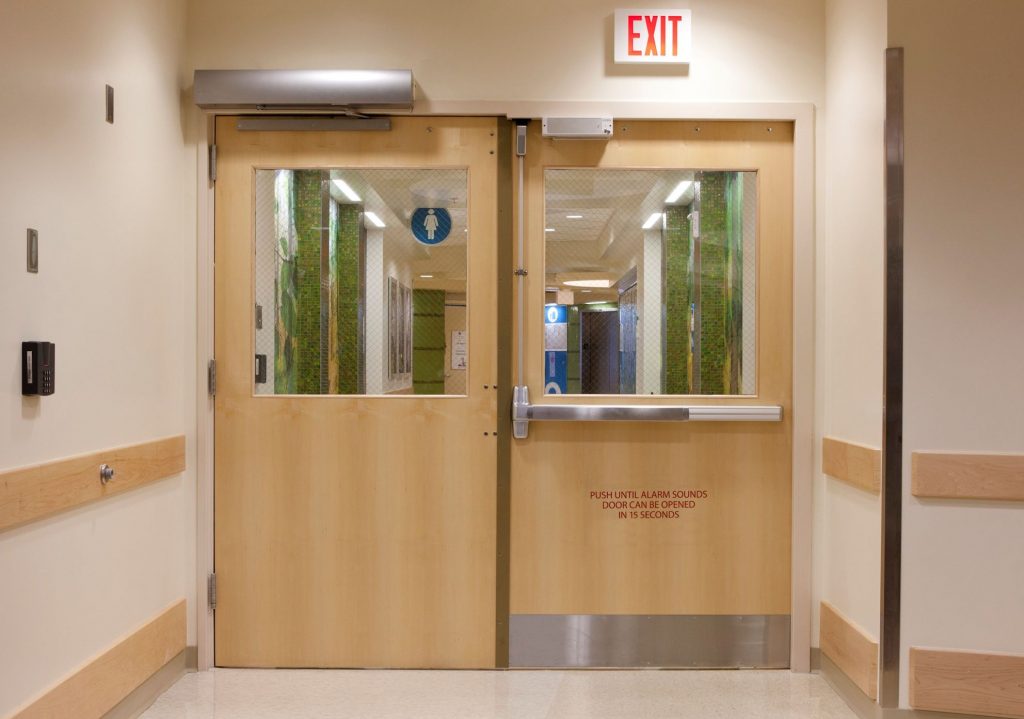 A delayed egress lock is a type of electrified hardware that prevents egress for 15 seconds (or 30 seconds where allowed by the Authority Having Jurisdiction (AHJ)). When a building occupant attempts to exit through a door equipped with a delayed egress lock, an alarm will sound and the door will remain locked; signage is required to be mounted on the door explaining the operation of the lock. When the time delay is complete, the door may then be opened by normal operation of the hardware, to allow building occupants to exit. If there is a fire alarm or power failure, the delayed egress lock must allow immediate egress with no delay. The products commonly used for delayed egress applications include panic hardware / fire exit hardware or electromagnetic locks that incorporate delayed egress circuitry..
A delayed egress lock is a type of electrified hardware that prevents egress for 15 seconds (or 30 seconds where allowed by the Authority Having Jurisdiction (AHJ)). When a building occupant attempts to exit through a door equipped with a delayed egress lock, an alarm will sound and the door will remain locked; signage is required to be mounted on the door explaining the operation of the lock. When the time delay is complete, the door may then be opened by normal operation of the hardware, to allow building occupants to exit. If there is a fire alarm or power failure, the delayed egress lock must allow immediate egress with no delay. The products commonly used for delayed egress applications include panic hardware / fire exit hardware or electromagnetic locks that incorporate delayed egress circuitry..
 Controlled egress is an application that is allowed in health care facilities where patients require containment for their safety, or for security reasons; this application is not allowed in other occupancy types. Doors equipped with controlled egress locks do not release automatically after 15 seconds, an alarm is not required to sound, and signage is not mandated by the model codes. When the doors are needed for emergency evacuation, the model codes specify several criteria by which the doors must be made available for egress. A controlled egress lock may be preferred over a delayed egress lock for a memory care facility, for example, to prevent patient elopement and avoid the audible alarm that is required for delayed egress applications. For controlled egress applications electromagnetic locks are often used, or electrified panic hardware / fire exit hardware that secures the door indefinitely on the egress side..
Controlled egress is an application that is allowed in health care facilities where patients require containment for their safety, or for security reasons; this application is not allowed in other occupancy types. Doors equipped with controlled egress locks do not release automatically after 15 seconds, an alarm is not required to sound, and signage is not mandated by the model codes. When the doors are needed for emergency evacuation, the model codes specify several criteria by which the doors must be made available for egress. A controlled egress lock may be preferred over a delayed egress lock for a memory care facility, for example, to prevent patient elopement and avoid the audible alarm that is required for delayed egress applications. For controlled egress applications electromagnetic locks are often used, or electrified panic hardware / fire exit hardware that secures the door indefinitely on the egress side..
There are numerous requirements that apply to delayed egress and controlled egress applications, and these requirements vary depending on which model code is being enforced. View the video and/or check out this article on controlled egress locking systems and this article on delayed egress locking systems. This (optional) Decoded article addresses an important change in the 2018 IBC related to delayed egress locks.
For more in-depth information about the code requirements that apply to delayed egress and controlled egress, there is a recorded master class available on the Webinars page of iDigHardware.com (optional).
After reviewing these materials, proceed to the review questions below.
~~~
Review Questions
1. According to the model codes, which of the following criteria is NOT required to be met when a delayed egress lock is used?
- The timer must begin after a force is applied for up to 3 seconds.
- The lock must be rearmed manually after it is actuated by a building occupant.
- Staff must carry the keys, codes, or other credentials to unlock the door.
- A local audible alarm must sound at the door, and instructional signage must be mounted on the door.
- The door must allow egress after 15 (or 30) seconds, and immediately upon fire alarm activation and/or power failure.
2. According to the model codes, which of the following criteria IS required to be met when a controlled egress lock is used?
- The timer must begin after a force is applied for up to 3 seconds.
- The lock must be rearmed manually after it is actuated by a building occupant.
- Staff must carry the keys, codes, or other credentials to unlock the door.
- A local audible alarm must sound at the door, and instructional signage must be mounted on the door.
- The door must allow egress after 15 (or 30) seconds, and immediately upon fire alarm activation and/or power failure.
3. On which of the following buildings would the IBC allow a delayed egress lock to be installed on a door in the means of egress (if all of the other criteria were met)?
- Boston public library
- A big-box retail store
- A hotel ballroom
- University of Tennessee lecture hall
- None of the above
Answers: 1 – C, 2 – C, 3 – B
